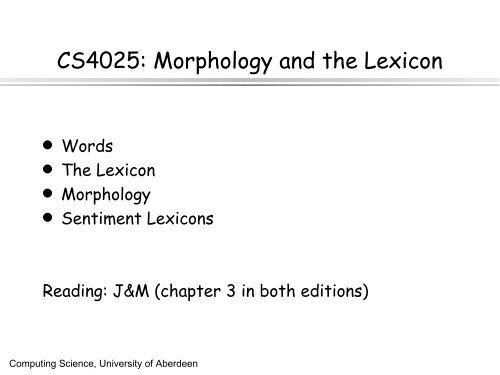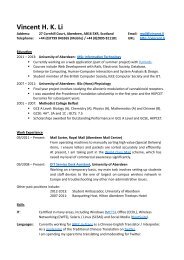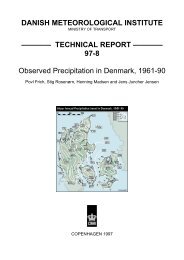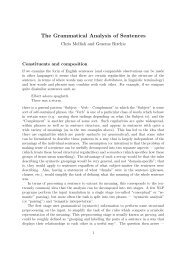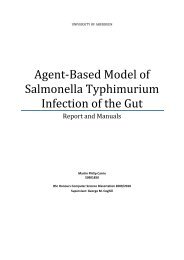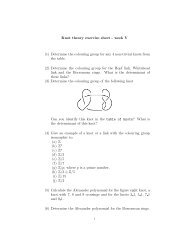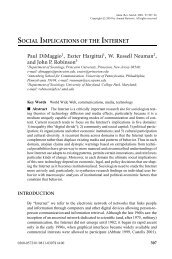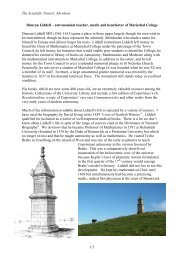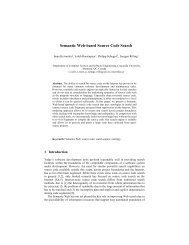Natural-Language Processing - Homepages | The University of ...
Natural-Language Processing - Homepages | The University of ...
Natural-Language Processing - Homepages | The University of ...
Create successful ePaper yourself
Turn your PDF publications into a flip-book with our unique Google optimized e-Paper software.
CS4025: Morphology and the Lexicon<br />
● Words<br />
● <strong>The</strong> Lexicon<br />
● Morphology<br />
● Sentiment Lexicons<br />
Reading: J&M (chapter 3 in both editions)<br />
Computing Science, <strong>University</strong> <strong>of</strong> Aberdeen
Types <strong>of</strong> Words<br />
Open-class, content words:<br />
● Nouns (shoe, tablecloth, cause, E-insertion…)<br />
● Verbs (see, walk, cause, forget, promise, …)<br />
● Adjectives (big, small, reliable, three-legged, …)<br />
● Adverbs (quickly, well, reliably, …)<br />
Function (closed-class) words<br />
» prepositions, determiners etc<br />
See J&M, sect 8.1<br />
Computing Science, <strong>University</strong> <strong>of</strong> Aberdeen
Lexicons<br />
● Lexicons are databases <strong>of</strong> word information.<br />
● “Dictionary” <strong>of</strong> NLP system<br />
● A good lexicon is critical to performance<br />
» “the system with the bigger lexicon always wins”<br />
Computing Science, <strong>University</strong> <strong>of</strong> Aberdeen
Dictionary: Child<br />
<strong>The</strong> following is, <strong>of</strong> course, written for humans:<br />
●<br />
child \'chi-(*)ld\ n pl children [ME, fr. OE cild] 1a: an unborn or<br />
recently born person 1b: dialect: a female infant 2a: a young person<br />
<strong>of</strong> either sex esp. between infancy and youth 2b: a childlike or<br />
childish person 2c: a person not yet <strong>of</strong> age...<br />
» [From Webster’s on-line dictionary]<br />
Computing Science, <strong>University</strong> <strong>of</strong> Aberdeen
Word Information<br />
An NLP system needs to know<br />
» Spelling<br />
» Category and subcategory<br />
» Inflections (plurals, past, etc)<br />
» What word corresponds to in DB or KB<br />
» Statistical information<br />
» maybe pronunciation<br />
» probably not derivation<br />
Computing Science, <strong>University</strong> <strong>of</strong> Aberdeen
Example: Person<br />
● Person<br />
» Category: noun<br />
» Subcategory: count noun<br />
» Inflections: plural = people<br />
» Database correspondence: person class.<br />
» Frequency: .03%<br />
Computing Science, <strong>University</strong> <strong>of</strong> Aberdeen
Word Meaning<br />
● What do these words mean<br />
» He told a lie<br />
» <strong>The</strong> temperature fell in the afternoon<br />
● Many subtleties, difficult to represent<br />
● Most NLP systems ignore, use very simple models<br />
<strong>of</strong> meaning<br />
Computing Science, <strong>University</strong> <strong>of</strong> Aberdeen
Digression: Two approaches to word<br />
meaning<br />
Create a network <strong>of</strong> all possible word senses, with<br />
links between them (e.g. for hyponym, antonym).<br />
A word then has a number <strong>of</strong> these possible<br />
senses (WordNet) – this is an expensive<br />
undertaking.<br />
1. Try to decompose word senses into complex<br />
expressions involving primitive concepts (Schank,<br />
Jackend<strong>of</strong>f) – only possible in limited sense areas.<br />
In either case, the senses/concepts need to be<br />
related to domain objects (e.g. database fields)<br />
[See later lecture on Semantics]<br />
Computing Science, <strong>University</strong> <strong>of</strong> Aberdeen
1. Network <strong>of</strong> words and senses<br />
Computing Science, <strong>University</strong> <strong>of</strong> Aberdeen
2. Decomposition <strong>of</strong> meaning into<br />
primitives<br />
KILL =<br />
CAUSE TO die =<br />
CAUSE TO NOT LIVE<br />
THROW =<br />
project WITH hand =<br />
(CAUSE to MOVE) WITH BODYPART<br />
General inference rules can be formulated in terms<br />
<strong>of</strong> CAUSE, NOT, WITH etc.<br />
Computing Science, <strong>University</strong> <strong>of</strong> Aberdeen 1
Lexicon Structure<br />
● Object-oriented representation<br />
» Noun, Verb, etc are classes<br />
» Individual words are instances<br />
» Slots (data members) hold information.<br />
● Use <strong>of</strong> inheritance<br />
» Members <strong>of</strong> a class inherit properties (e.g. values <strong>of</strong><br />
slots, applicable rules)<br />
» Multiple inheritance is common<br />
Computing Science, <strong>University</strong> <strong>of</strong> Aberdeen 1
Example: Lexicon Structure<br />
Word<br />
Noun<br />
Verb<br />
Adjective<br />
Intransitive<br />
Transitive<br />
Bitransitive<br />
sleep eat have give<br />
Computing Science, <strong>University</strong> <strong>of</strong> Aberdeen 1
Computing Science, <strong>University</strong> <strong>of</strong> Aberdeen 1
Morphology<br />
● Variations <strong>of</strong> a root form <strong>of</strong> a word<br />
» prefixes, suffixes<br />
● Inflectional morph - same core meaning<br />
» plurals, past tense, superlatives<br />
» part <strong>of</strong> speech unchanged<br />
● Derivational morph - change meaning<br />
» prefix re means do again: reheat, resit<br />
» suffix er means one who: teacher, baker<br />
» part <strong>of</strong> speech changed<br />
Computing Science, <strong>University</strong> <strong>of</strong> Aberdeen 1
Noun Inflections<br />
● Nouns are inflected to form plurals, usually by<br />
adding s<br />
● Example<br />
» chair - Tom has one chair<br />
» chairs - John has 2 chairs<br />
● Also possessive inflection with ‘s<br />
» <strong>The</strong> boy’s mother<br />
Computing Science, <strong>University</strong> <strong>of</strong> Aberdeen 1
Adjective Inflections<br />
● Adjectives are inflected to form comparative (er)<br />
and superlative (est) forms.<br />
● Example:<br />
» fast - A Sun is fast.<br />
» faster - A Sun is faster than a PC.<br />
» fastest - <strong>The</strong> Cray is the fastest computer<br />
Computing Science, <strong>University</strong> <strong>of</strong> Aberdeen 1
Verb Inflections<br />
● Tense and aspect<br />
» infinitive (root) - I like to walk to the store<br />
» past (ed) - I walked to the store<br />
» past participle (ed or en) - I have walked to the store<br />
» present participle (ing) - I am walking to the store.<br />
● Agreement with subject<br />
» pres/3sing (s) - John walks to the store<br />
Computing Science, <strong>University</strong> <strong>of</strong> Aberdeen 1
Spelling Changes<br />
● Some spelling changes are automatically made<br />
when adding a suffix to a word.<br />
● Delete final “e” when ending starts with a vowel<br />
» write + ing = writing, not writeing<br />
● Change final “y” to “i”<br />
» fry + ed = fried, not fryed<br />
Computing Science, <strong>University</strong> <strong>of</strong> Aberdeen 1
Irregular forms<br />
● Some words have irregular forms that must be<br />
looked up in a dictionary<br />
» plural <strong>of</strong> child is children, not childs<br />
» past <strong>of</strong> eat is ate, not eated<br />
● Irregular forms are usually maintained when a<br />
prefix is added<br />
» past <strong>of</strong> rethink is rethought<br />
Computing Science, <strong>University</strong> <strong>of</strong> Aberdeen 1
Tasks<br />
● Morphological analysis<br />
» Replace inflected forms by root+inflection<br />
– <strong>The</strong> children ate apples becomes<br />
– <strong>The</strong> child+s eat+ed apple+s<br />
● Morphological generation<br />
» Replace root+inflection by inflected forms<br />
– <strong>The</strong> child+s eat+ed apple+s becomes<br />
– <strong>The</strong> children ate apples<br />
Computing Science, <strong>University</strong> <strong>of</strong> Aberdeen 2
Implementation – 1: stemming<br />
● Standard endings, spelling changes<br />
» 2 pages <strong>of</strong> code<br />
» Porter stemmer in Information Retrieval<br />
conditon suffix replacement examples<br />
(*V*) ed null plastered->plaster,<br />
bled->bled<br />
● Dictionary <strong>of</strong> special cases<br />
» 1500 special case rules (Sussex morpha)<br />
● More complex processing is needed for languages<br />
with complex morphology.<br />
Computing Science, <strong>University</strong> <strong>of</strong> Aberdeen 2
Real Morphology (Turkish)<br />
●<br />
Uygarlastiramadiklarimizdanmissinizcasina<br />
» uygar -civilized<br />
» +las +BEC (become)<br />
» +tir +CAUS (cause to)<br />
» +ama +NEGABLE (not able)<br />
» +dik +PPART (past tense)<br />
» +lar +PL (plural)<br />
» +imiz +P1PL (first person plural - we)<br />
» +dan +ABL<br />
» +mis +PAST<br />
» +siniz +2PL<br />
» +casina +ASIF<br />
» “(behaving) as if you are among those whom we could not<br />
civilize/cause to become civilized”<br />
Computing Science, <strong>University</strong> <strong>of</strong> Aberdeen 2
Finite State Automatons<br />
Computing Science, <strong>University</strong> <strong>of</strong> Aberdeen 2
FSAs for morphology<br />
Ending Node<br />
Starting Node<br />
Computing Science, <strong>University</strong> <strong>of</strong> Aberdeen 2
Properties <strong>of</strong> Finite State Automatons<br />
● Recognition (is a string valid, and analysis) is in<br />
Linear time<br />
● FSAs are reversible, can be used to generate as<br />
well as analyse<br />
Computing Science, <strong>University</strong> <strong>of</strong> Aberdeen 2
Finite State Transducers<br />
● Sometimes useful to have two tapes<br />
(irregular plurals)<br />
Computing Science, <strong>University</strong> <strong>of</strong> Aberdeen 2
FST for plurals with empty characters<br />
Computing Science, <strong>University</strong> <strong>of</strong> Aberdeen 2
Implementation – 2: analysis &<br />
generation<br />
● Express possible word analyses as simple<br />
concatenations <strong>of</strong> morphemes, e.g. “in+probable+ly”<br />
(can express allowable combinations via a finite<br />
state automaton)<br />
● Represent the principles <strong>of</strong> a particular spelling<br />
change (e.g. “in+p -> imp”) in a mapping between<br />
this and the surface form which enforces this but<br />
leaves everything else unchanged<br />
● Mappings can be implemented by finite state<br />
transducers, which can efficiently test<br />
correctness.<br />
Computing Science, <strong>University</strong> <strong>of</strong> Aberdeen 2
Morphology as tape-tape mapping<br />
TAPE 1 i n + p r o b a b l e + l Y<br />
TAPE 2 i m p r o b a b l y<br />
Different (partial) mappings involved:<br />
• n_to_m: Knows about when to legally transform n to m<br />
• lely_to_ly: Knows about when to legally transform le to<br />
empty string<br />
• …<br />
Computing Science, <strong>University</strong> <strong>of</strong> Aberdeen 2
Finite State Transducers (FSTs)<br />
● A finite state transducer is like a finite state<br />
automaton, except that it accepts two tapes,<br />
rather than one.<br />
● Each transition has a label a:b where a is a symbol<br />
to appear on the first tape and b on the second<br />
● Abbreviations can be used to specify sets <strong>of</strong><br />
symbols (the actual FST will have multiple<br />
transitions corresponding to each <strong>of</strong> these).<br />
● FSTs can be used to express a mapping between<br />
the first tape and the second.<br />
● FSTs: J&M (2 nd Edition) section 3.4<br />
Computing Science, <strong>University</strong> <strong>of</strong> Aberdeen 3
Parallel FSTs for morphology<br />
(Can compile a set<br />
<strong>of</strong> parallel FSTs<br />
into one giant<br />
FST)<br />
Computing Science, <strong>University</strong> <strong>of</strong> Aberdeen 3
Summary<br />
● <strong>The</strong> lexicon is a vital part <strong>of</strong> an NLP system<br />
● Lexicons need to be organised properly to ease<br />
creation and maintenance (e.g. object oriented)<br />
● Various information needs to be stored about a<br />
word<br />
● Words belong to classes and change in form<br />
according to rules <strong>of</strong> morphology (2 kinds)<br />
● Simple analysis <strong>of</strong> regular morphology is quite easy<br />
for English (Porter stemmer)<br />
● Other languages or more complete coverage may<br />
require more sophisticated techniques (FSTs)<br />
Computing Science, <strong>University</strong> <strong>of</strong> Aberdeen 3
Specialised Dictionaries<br />
http://www.wjh.harvard.edu/~inquirer/homecat.htm<br />
Includes Sentiment dictionaries, and related<br />
categories<br />
Computing Science, <strong>University</strong> <strong>of</strong> Aberdeen 3
Introduction to Python<br />
● Syntax:<br />
» NewLine seperates commands (no ;s)<br />
» Tabs are important: they are used to mark blocks (no {}s)<br />
def Function1 (a,b):<br />
c=a*b<br />
return c<br />
def Function2 (a,b):<br />
c=a+b<br />
return c<br />
print “s=%d, p=%d” % (Function1(2,3), Function2(2,3))<br />
Computing Science, <strong>University</strong> <strong>of</strong> Aberdeen 3
Introduction to Python<br />
● Lists:<br />
» Like Arrays (integer indices)<br />
word[0] = “the”<br />
word[1] = “apple”<br />
● Dictionaries:<br />
» Allow string indicies (implemented internally as hashes)<br />
frequency[“the”] = 37<br />
frequency[“apple”] = 3<br />
● Enumeration<br />
for x, y in enumerate(word)<br />
for x, y in frequency.iteritems():<br />
Computing Science, <strong>University</strong> <strong>of</strong> Aberdeen 3


